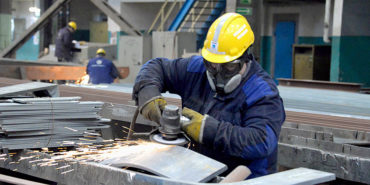Is there a definiteaxial weight of objects carried by one person?
In order to eliminate the need for manual handling of loads, the employer should ensure that appropriate organisational and technical solutions are applied. If, on the other hand, this cannot be avoided, workers should be provided with measures that will reduce the associated nuisances and risks. The regulations specify the maximum weight of items carried by one employee.
In accordance with the provisions of labor law, the employer is responsible for the state of occupational health and safety in the plant and is obliged to protect the health and life of employees.
In accordance with paragraph 62 of the Regulation of the Minister of Labour and Social Policy of 26 September 1997 on general occupational health and safety regulations, the employer should ensure the use of appropriate organizational and technical solutions, especially in the field of technical equipment, in order to eliminate the need for manual handling of loads. If, on the other hand, it is not possible to avoid the manual handling of loads, appropriate measures should be taken, including equipping workers with the necessary measures to reduce the nuisance and risks associated with the performance of these activities. These obligations were repeated in the Regulation of the Minister of Labour and Social Policy of 14 March 2000 on occupational health and safety in manual transport work and other work related to physical effort (hereinafter referred to as: the Regulation).
The employer is obliged to assess the occupational risks occurring in manual transport work, in particular taking into account:
- the mass of the object to be moved, its nature and the position of the center of gravity;
- working environment conditions, including in particular air temperature and humidity and the level of factors harmful to health;
- the organization of work, including the ways in which work is carried out;
- individual predispositions of the employee, such as physical fitness, age and state of health.
Risk assessment should be carried out when organizing manual transport work, as well as after each change in the organization of work. On its basis, the employer is obliged to take action to remove the identified threats.
The provisions of the regulation assume that before allowing manual transport work, the employer is obliged to train employees in the field of occupational health and safety, including in particular in the correct ways of performing manual transport work. It should also provide information on the object being moved, in particular: its mass and the location of its centre of gravity. In addition, it is the employer’s responsibility to inform employees about all aspects of occupational health and safety and ergonomic requirements, including the results of the occupational risk assessment and safety measures to prevent injuries. However, if it is found that the way of performing work is incorrect and poses risks, the employer is obliged to ensure that it is suspended until appropriate actions are taken to eliminate these risks.
Pursuant to paragraph 6 of the Regulation, the organisation of manual transport work, including the working methods used, should ensure in particular:
- reduction of long-term physical exertion, including the provision of adequate breaks in work for rest;
- elimination of excessive load on the musculoskeletal system of the worker, and especially spinal injuries, associated with the rhythm of work forced by the work process;
- minimizing the distance of manual movement of objects;
- taking into account ergonomic requirements.
The provisions of the Regulation require that when manually moving objects, if possible, auxiliary equipment appropriate to their size, weight and type is provided, ensuring safe and convenient performance of work.
The surface on which objects are moved by hand should be even, stable and non-slippery. On the other hand, passages, transport routes and tracks and tracks on which objects are moved should meet the requirements of occupational health and safety set out in separate regulations. The provisions of the Regulation require that in the case of work related to the manual movement of objects, sufficient space be provided, especially in the vertical plane, to maintain the correct position of the worker’s body during work. Manual movement of objects through rooms, stairs, corridors or doors too narrow in relation to the size of those objects, if this creates accident risks, was considered unacceptable.
In addition, in certain situations, the need to avoid manual movement of objects should be taken into account. These are several cases listed in the regulation. As an example, attention should be paid to situations where:
- the item is too heavy, too large, bulky or difficult to maintain according to the assessment of the person managing the employees;
- the object is unstable or its contents may move;
- the shape or structure of the object may cause injury to the worker, especially in the event of a collision;
- sudden movements of the object may occur;
- the floor or surface of the foot rest is unstable;
- the object limits the worker’s field of vision;
- temperature, humidity and ventilation are not adapted to the work performed.
According to paragraph 10 of the Regulation, in a situation where work is carried out related to the manual movement of bulky, unstable, variable centre of gravity and other objects which, due to their weight, shape or properties, may cause an accident risk, the employer must specify in the instructions detailed rules for safe handling when moving such objects. That instruction shall specify, in particular, the procedures to be followed for the movement of those objects.
Sharp, protruding elements of moving objects should be protected in such a way as to prevent injuries. On the other hand, packaging should be made of sufficiently durable materials and should not pose accident risks related in particular to their shape, including sharp edges. If the shape or size of packaging intended for the manual handling of objects makes it difficult or impossible to move them safely, it shall be fitted with appropriate handles. In addition, the arrangement of items in packages should ensure their stability during movement.
The net energy expenditure necessary to perform work related to physical exertion, including lifting and moving objects, during the working shift shall not exceed:
- for women 5000 kJ, and for casual work 20 kJ/min;
- for men 8400 kJ, and for casual work 30 kJ/min.
The mass of objects lifted and carried by a single worker must not exceed:
- for women – 12 kg for permanent work and 20 kg for casual work (that is, manual movement of objects, loads or materials no more than 4 times per hour, if the total time of performing these works does not exceed 4 hours a day);
- for men – 30 kg for permanent work and 50 kg for casual work.
The mass of objects lifted by one worker to a height above the shoulder girdle must not exceed:
- for women – 8 kg for permanent work and 14 kg for casual work;
- for men – 21 kg for permanent work and 35 kg for casual work.
If the objects are moved by one worker over a distance exceeding 25 metres, the mass of the objects carried must not exceed:
- for women – 12 kg,
- for males – 30 kg.
Where objects are carried uphill by one worker over an uneven surface, ramp or staircase the maximum angle of inclination of which does not exceed 30° and the height exceeds 4 metres, irrespective of the distance to which the objects are moved, the mass of these objects shall not exceed:
- for women – 12 kg,
- for males – 30 kg.
Where objects are moved uphill by one worker over an uneven surface, ramp or staircase the maximum angle of inclination of which exceeds 30° and the height exceeds 4 metres, irrespective of the distance to which the objects are moved, the mass of these objects shall not exceed:
- for women – 8 kg for permanent work and 12 kg for casual work;
- for men – 20 kg for permanent work and 30 kg for casual work.
The handling of objects the length of which exceeds 4 m and the weight exceeds 30 kg for men and 20 kg for women should be carried out in a team, provided that there is a weight per worker not exceeding:
- for permanent work – 25 kg for males and 10 kg for females;
- for casual work – 42 kg for males and 17 kg for females.
It is not allowed to move objects by hand in teams over a distance exceeding 25 m or weighing more than 500 kg for men and 200 kg for women.
In accordance with paragraph 18(1) of the Regulation, the collective transfer of objects must ensure the selection of workers in terms of height and age and the supervision of a worker experienced in the use of appropriate means of manual movement of objects and the organisation of work, designated for this purpose by the employer. It is also necessary to ensure spacing between employees – at least 0.75 m and the use of appropriate auxiliary equipment.
The organization and methods of work related to the manual handling of materials that may pose hazards due to their properties (corrosive, poisonous, dusty) should eliminate or reduce these risks. The provisions of the regulation consider it unacceptable for one employee to carry liquid materials – hot, corrosive or with properties harmful to health, the weight of which together with the vessel and handle exceeds 25 kg for men and 10 kg for women. Glass balloons with acids or other corrosive liquids, on the other hand, should be transported on special trolleys. Only in exceptional cases can they be carried by two workers in suitably durable baskets with handles. It is unacceptable to carry these balloons on your back or in front of you.
Source: https://www.prawo.pl/kadry/normy-dzwigania-dla-jednej-osoby-przy-recznych-pracach,187639.html

Projekt otrzymał dofinansowanie z Norwegii poprzez Fundusze Norweskie 2014-2021, w ramach programu „Dialog społeczny – godna praca”.





